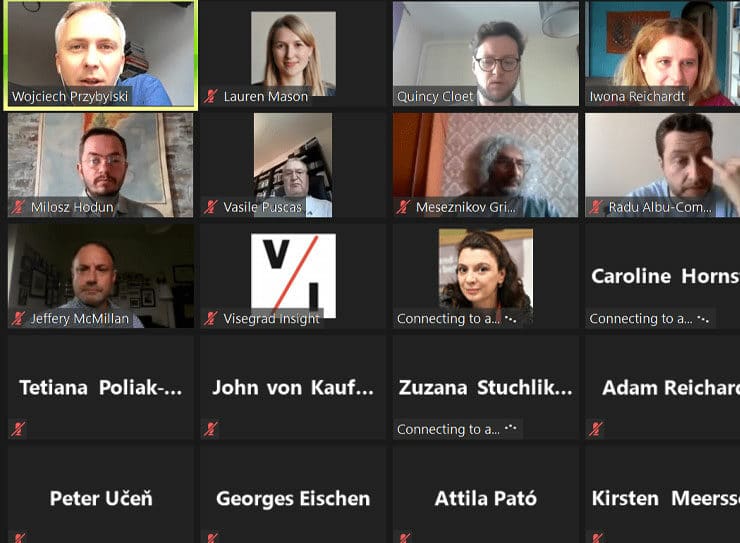21 July 2020
Hard to Ignore– V/I Breakfast in cooperation with ELF
What’s Next for Civil Society in Central Europe? Underneath the bustle and vibrancy of civil society organisations in the region, […]

What’s Next for Civil Society in Central Europe? Underneath the bustle and vibrancy of civil society organisations in the region, […]

What’s Next for Civil Society in Central Europe?
Underneath the bustle and vibrancy of civil society organisations in the region, a bleaker picture of the sector emerges in terms of structure and sustainability. Can promising developments in strategic sectors such as transnational cooperation and digitalisation shift the current trajectory?
Since 1989, civil society has had to meet high expectations following the transformation while operating in a politicised and polarised context. The challenges and threats to the sector are gaining attention again, not only because of the COVID-19 pandemic in recent months but also because of growing signs of democratic backsliding and civil liberties under pressure in Central Europe.
The subject of a recent Visegrad Insight Breakfast discussion in partnership with the European Liberal Forum deals with trends and future scenarios for civil society in Central Europe. The regular gathering format continues to take place online, which allows for a greater number of participants to discuss ongoing developments in Central Europe and to make sense of what is happening at times of the pandemic crisis.
Affirmation of people’s agency
During the online meeting, Simona Merkinaite, Programme Coordinator at the Open Lithuania Foundation, talks about the current democratic crisis as a premise for the project #Rethink1989 – organised in cooperation with Visegrad Insight.
The #Rethink1989 project aims at understanding which are the main reasons for the democratic backsliding in the region. One of the key paradoxes here is the fact that the same elites, who were at the forefront of the democratic revolutions in the 1980s and the 1990s, are now fierce critics of the values that emerged through these very revolutions.
One possible approach is to reach out to the civil society workers and get to know their understanding of the civil societies depending on the given contexts. For instance, in the case of Baltics states, the understanding of the relation between the civil society and the state sectors is characterised by the Soviet heritage and still visible at local levels.
Another indicator of these processes is the dependence on public funds and Merkinaite asks the question whether civil society can be independent in such contexts.
On a different level, one can say that the voice of dissent and the political engagement had real consequences in the pre-1989 period. Back then, there was a rather unified cause against the regime while today there is a spectrum of scattered causes.
A different experience of democracy and civil liberties
Quincy Cloet, the Managing Editor at Visegrad Insight, raises several noteworthy points from the recently published Civil Society Futures: Scenarios for Central Europe report. In spatial terms, according to the most recent international indicators, civil society in Central Europe is either stagnating (Czechia and Slovakia) or declining (Poland and Hungary).
With regard to financial matters, civil society still feels the impact of the economic crisis of 2008-09 and will be further hampered by the consequences of the COVID-19 pandemic.
Civil society in the region also had to face a number of social challenges – such as rapid digitalisation and the shift to organising a range of activities for the community online. Cloet thinks that the restrictions for physical contacts provoked by the pandemic could further facilitate these processes.
Another challenge is driven by a generational change. While many young people have been active in protests in recent years, because of discontent with government and the political class, their experience with democracy and civil liberties is also different to the generation that lived through the post-1989 transition process.
Alliances crossing national borders
Milosz Hodun, the President of Projekt: Polska Foundation and member of the ELF Board of Directors, highlights a number of optimistic trends for civil society in the Central European region.
Firstly, one can observe a clear coalition-building process among non-governmental organisations in Central Europe, especially among those based in countries with illiberal regimes. This is a reaction to the fragmentation and the vulnerability of civil society.
Secondly, he emphasises that there is a stronger transnational and European cooperation among civil society actors. Even during the time of crisis, multiple regional organisations built even bigger alliances crossing national borders.
For Hodun, the third trend is the creation of grassroots movements in the last few years and most visible in Poland after 2015. While some organisations ceased to exist, others have become very powerful following a wave of protests.
Finally, Hodun sees the fourth trend in the political engagement of civil society activists in the region. This is visible in all of the Visegrad Group countries, with the Hungarian Momentum, Slovakia’s Together for the people and the Pirate Party in Czechia as notable examples.
In his view, these activists have decided to fight democratic backsliding and other related developments on a different level, where they can have a greater impact on society.
This is the summary of an event organised by ELF in cooperation with Visegrad Insight.